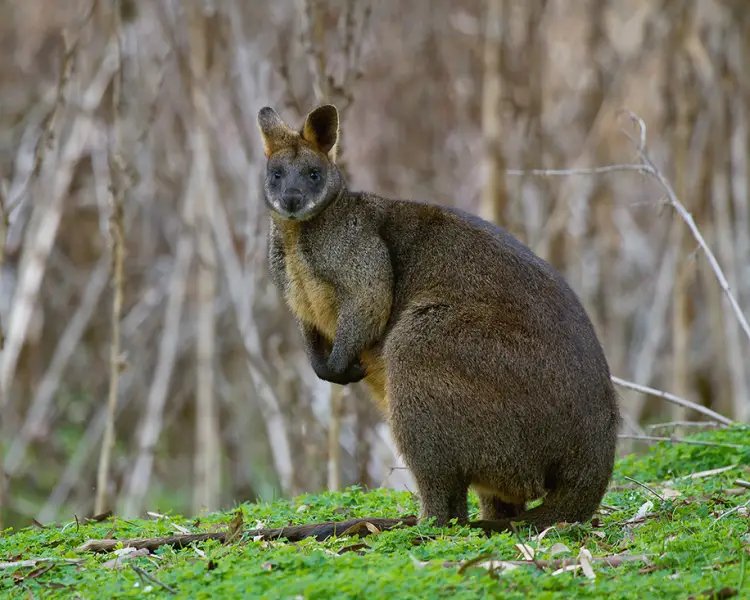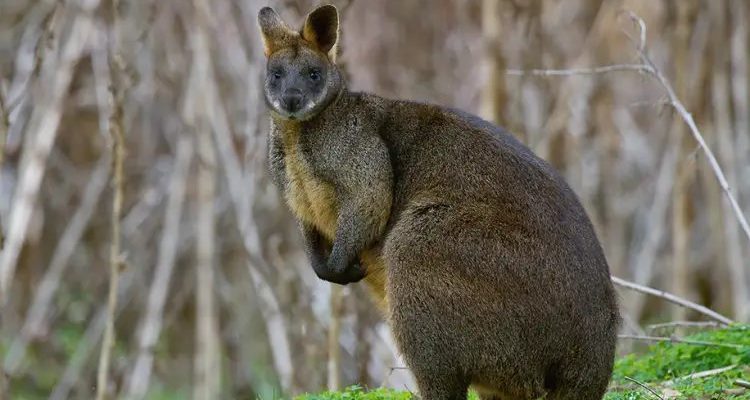
Swamp wallabies, with their sturdy bodies and adorable faces, are often found hopping around in coastal swamps and dense forests. They’re more than just cute critters; they have a whole way of life that revolves around raising their young. Let’s dive into the world of swamp wallabies and explore the intricacies of their parenting, from pregnancy to the moment their little ones hop into the world.
The Role of Mother Swamp Wallabies
In the world of swamp wallabies, the mother is the central figure in raising the young. She plays a crucial role in their survival, much like a captain steering a ship through stormy seas. The female wallaby carries her tiny joey in her pouch, a cozy little haven where it can grow and develop safely.
The gestation period for swamp wallabies is about 30-40 days, and it’s quite the journey for the developing baby. Once the joey is born, it’s only a fraction of an inch long—just a squishy little blob that immediately makes its way to the pouch, which is where it will spend most of its early life. Imagine being in a warm, secure bubble where everything you need is right at your fingertips!
As the joey grows, the mother keeps a watchful eye, providing nourishment and keeping her little one safe from predators. It’s a tough job, full of responsibilities, but she handles it with grace. The pouch isn’t just for comfort; it’s a nurturing environment where the joey can feed on its mother’s milk and grow strong.
The Growth of the Joey
After spending around six months in the pouch, the joey starts to emerge—this is where the fun really begins! At first, it might peek out, curious about the world beyond its cozy home. This phase is crucial, as the joey learns to navigate life outside the pouch, much like a toddler taking its first steps.
During this period, the mother continues to provide milk, but she also introduces her young one to solid food. Swamp wallabies are herbivores, so they munch on grass, leaves, and shoots. The mother shows her joey what to nibble on, teaching it essential survival skills. Imagine a little wallaby hopping around, mimicking its mom as it experiments with different plants—it’s both adorable and vital for its development!
The bond between the mother and the joey is essential during this time. They communicate through soft sounds and body language, strengthening their connection. This nurturing environment lays the foundation for the joey’s future independence.
The Importance of Early Learning
You might be wondering why early learning is so critical for swamp wallabies. Well, the skills a joey picks up in its first year can determine its survival as an adult. For instance, learning to recognize potential threats helps them avoid danger later on.
Mother swamp wallabies are vigilant. They often choose safe spots for grazing where they can keep an eye out for predators like eagles or dingoes. As the joey explores its surroundings, it learns to be cautious and aware of these dangers. Think of it as a young child learning to look both ways before crossing the street—it’s all about safety!
Also, mother wallabies introduce their joeys to social behaviors. They interact with other wallabies, showing their young how to socialize and navigate relationships. This experience is crucial for a wallaby’s growth into a healthy adult capable of thriving in the wild.
Independence Day: When the Joey Leaves the Pouch
After around six months, the time comes when the joey is ready to fully leave the pouch. This moment can be quite bittersweet for the mother. It’s like sending your child off to their first day of school; you’re proud but also a little sad to see them grow up.
Once the joey hops out, it will still return to the pouch for a bit as it gathers confidence. This transition is essential; it allows the juvenile wallaby to gain independence while still having the safety net of its mother. It’s a balancing act—learning to be independent while still nurturing that bond.
During this phase, the joey continues to learn about foraging and avoiding danger. It’s like stepping into a training program for life, where every hop and nibble is a chance to gain more skills.
Challenges Faced by Swamp Wallabies
Raising young in the wild isn’t all sunshine and rainbows. Swamp wallabies face numerous challenges that can affect their ability to rear their young. Habitat loss due to urban development is a significant concern. These wallabies thrive in dense vegetation, and losing their home makes raising a joey far more difficult.
Additionally, natural predators pose a constant threat. During early development, a joey is vulnerable, and mother wallabies must be on high alert. They use their keen senses to detect danger, often choosing to stay in safer areas when raising their young.
Human intervention also plays a part. Car accidents are a major hazard for these creatures, and sometimes, wallabies may wander into dangerous situations. Conservation efforts are crucial to help protect these adorable animals and their habitats.
Conservation and the Future of Swamp Wallabies
Protecting swamp wallabies and their young is essential for the future of these unique creatures. Conservation efforts are underway to preserve their natural habitats and raise awareness about their needs and challenges. Organizations are working to restore native vegetation and create safe corridors for wallabies to thrive.
Community involvement is also key. People can help by advocating for wildlife protection and supporting local initiatives focused on preserving natural habitats.
If you ever find yourself in Australia, keeping an eye out for swamp wallabies can be a delightful way to appreciate wildlife. Observing them in their natural habitat, especially with a joey peeking out, reminds us of the beauty of nature’s nurturing ways.
So, there you have it—a glimpse into the world of swamp wallabies and how they raise their young. These incredible animals remind us that parenting looks different in the wild, but the dedication to nurturing the next generation remains the same.
The journey from a tiny, squishy joey in a pouch to an independent wallaby is filled with lessons, challenges, and growth. By understanding their life cycle, we can appreciate the beauty of nature and the importance of conserving these adorable creatures. Next time you think about parenting, consider the swamp wallaby’s heartfelt approach—it might just inspire you!

